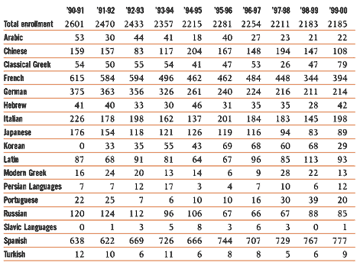|
December 6, 2000: Notebook Where trees once grew, apartments to blossom Tech Notes:Library switches catalog systems
Panagiotopoulos, who joined Princeton's faculty this summer from Cornell, grew up in Athens, Greece, and was a math and chemistry whiz, the perfect combination for a chemical engineer. He describes his work as "computational statistical mechanics of fluids and materials." What he does is make computer molecular models of fluids and materials and then use computations to predict their behavior. "We are trying to understand things like how dense they will be, how they will behave under flow, how strong they will be." Panagiotopoulos's computer sits on a work surface by the window in his tidy office in the Engineering Quad. There he builds his models, which can involve hundreds or thousands of molecules. The models are then sent to supercomputers, also located in the E-Quad, where for weeks the computers whir and calculate, following the motion of the molecules and predicting outcomes of behavior. "At the end," said Panagiotopoulos, "we have numbers that we can compare with the experimentalists." The outcome of the research can be new synthetic materials with interesting properties. One such product could be used as a drug delivery system, where the drug is encased in a material that mimics biological cells. This semester Panagiotopoulos
teaches a graduate class in statistical mechanics, and in the spring
he will teach a new undergraduate class, Molecular Modeling Methods.
By L.O.
Where trees once grew, apartments to blossom After more than 10 years on the drawing boards, Princeton Forrestal Center's plans to build 220 apartments in Plainsboro are moving closer to reality. A technical development review for the project, located on 55 acres near the Delaware and Raritan Canal, may come as early as this month, with groundbreaking possibly in spring or summer 2001. The Princeton Nurseries land, as the 448 acres are called, was incorporated into the Forrestal plan in 1987 after its purchase by the university, and includes plans for 2 million square feet of office space (up to 100,000 square feet of this could be developed as retail space). Three years ago, when the recession of the late 1980s and early 1990s had eased and it was economically feasible to move forward, Pizzo and Pizzo of Bridgewater was selected to build the luxury rentals, subject to government approvals. The university has constructed all necessary infrastructure, with the intention of developing this land according to existing zoning, says Robert Wolfe, Forrestal Center's general manager. The residential portion uses 24 acres and conserves 31 acres as open space along the canal (some 100 acres of the Nurseries parcel will remain preserved). In addition, a realignment of Mapleton Road bordering St. Joseph's Seminary is in the works. The office space plans are on hold; their generation will be "driven by the market," says David Knights, Forrestal's director of marketing. Local opposition has
surfaced on at least two fronts: the impact of development near
the canal and increased traffic. The Friends of Princeton Nurseries
Lands has called on the Delaware and Raritan Canal Commission to
"exert its authority" to preserve the canal corridor region,
says its cochair Charles Dieterich. Residents in Kingston, the nearby
300-year-old village that straddles Franklin and South Brunswick
townships, advocate a loop system in which traffic goes in and out
of Route 1 rather than through their community, says Glenn Davis,
chair of the Joint Citizens Advisory Task Force for the Village
of Kingston and associate director of the Office of Research at
the university. By Maria LoBiondo
Shown are two pages from
professor of Greek Martin Crusius's copy of the works of Homer.
The annotations made by Crusius give a glimpse into the 16th century
and how the world of Homer was made alive for students of that day. Over the course of 10 years, Princeton students have changed markedly the languages they choose to study. Especially noteworthy is the rise in the number of students studying Spanish. Premed students, for instance, are strongly encouraged to take Spanish, especially if they intend to work in urban areas, and Spanish 108 includes a number of vocabulary drills for them.
Tech Notes:Library switches catalog systems With more than 5 million volumes, 3 million microforms, and 1 million manuscripts, the Princeton University Library is always looking for better ways to catalog and manage the circulation of its collection. The Library's newest way is called Voyager "an integrated information management system," produced by Endeavor Information Systems. Marvin Bielawski, deputy university librarian, said the switch to Voyager from the previous catalog-system provider (NOTIS) was made for several reasons. The previous system was based on outdated hardware and software, and the new system simplifies many behind-the-scenes functions previously performed on separate databases. Voyager also provides an abundance of patron-empowerment options: easy Web access (http://catalog.princeton. edu/); sophisticated keyword searches; direct links to electronic journals, databases, and digital collections; access to one's own circulation record and book recall status, and the ability to print, e-mail, and download search results. The final switch between NOTIS and Voyager took place at the beginning of July, when catalog use was at a minimum. Though the switchover took only a few days, the preparation took more than a year and a half. Determined to eliminate the NOTIS mainframe system by 2002, the library formed a steering committee and several subcommittees to evaluate available cataloging systems. After narrowing down the market to three finalists, students and faculty were asked for their input to help make the final decision. Ultimately, the top choice
was Voyager, the same system used by the Library of Congress, the
National Library of Medicine, the University of Pennsylvania, and
Cornell. According to Bielawski, the system thus far has been "running
smoothly." By Andrew Shtulman '01 The governor of New Jersey, Christie Whitman, last month ordered an environmental impact statement (EIS) for the proposed Millstone Bypass roadway. The bypass is planned as an alternate to Route 1 and would cut through university property as it approaches the town of Princeton. (See PAW's map in the November 22 issue.) The state Department of Transportation had a few weeks earlier released its environmental assessment of the reconfiguration, and the project was on its way, after public hearings, to the Federal Highway Administration (FHA) for review. Whitman's order delays review by the FHA and calls for an intense environmental analysis, and taking into account social, historical, and economic effects. It also allows for more formal public input and requires a more comprehensive look at alternate configurations. Had no EIS been ordered, it was possible the project could have started in 2004. With an EIS under way, it could add two years or more to the timetable. For more information, go to www.state.nj.us/dot/roads/ rt1/penn_neck/.
Trendspotters and investors might have seen in the departure last month of Heidi Miller '74 from Priceline.com evidence that dot-com businesses are dying. Miller, a trustee of Princeton since 1999, had in February left Citigroup as its CFO to join Priceline, a name-your-own-price purchasing site, as its senior executive vice president and CFO. She left the online business after the company decided to retool, in the process laying off a number of employees. In the New York Times, Miller said that she didn't want to be part of "a workout situation." She also said that the shift in investor thinking has greatly impaired the growth prospects of Internet-based startups and wiped away much of their appeal to experienced executives like her. As of press time, Miller was in the market for a new job.
Laura M. Giles joined the art museum this month as associate curator of prints and drawings. Giles, who studied at Swarthmore, and earned her M.A. at Williams College and her Ph.D. at Harvard, comes from the Art Institute of Chicago.
That might not be the Nassau Hall bell sounding the hour, but it sure sounds like it. About a month ago, Jerrold Witsil, director of Public Safety, inaugurated an electronic ringer that chimes, or rather bongs, every hour from 7 a.m. to 11 p.m., no clapper needed. Located on the roof of East Pyne, the apparatus, with four speakers, broadcasts a recording taken from a time when the Nassau Hall bell still rang. The last time the hours were rung daily was about 10 years ago, when the clapper was finally removed for safety reasons. Robert Stengel, professor
of mechanical and aerospace engineering, was awarded the Mechanics
and Control of Flight Award by the American Institute of Aeronautics
and Astronautics. The award recognized his many contributions to
the theory and practice of aerospace control and guidance. Stengel
joined Princeton in 1977. Before that he was the principal designer
of the Apollo Lunar Module manual attitude control logic used for
all moon landings, and he contributed to the design of the space
shuttle guidance and control system. |
|||||||

 Water
is one of several fluids that Athanassios Panagiotopoulos, professor
of chemical engineering, studies. "I try to understand what
makes for its very unusual properties," he said. Unusual properties?
Water? "For instance, most fluids when heated expand, but water,
when it goes from 0 degrees Celsius to 4 degrees, the volume actually
goes down. We are trying to figure out why."
Water
is one of several fluids that Athanassios Panagiotopoulos, professor
of chemical engineering, studies. "I try to understand what
makes for its very unusual properties," he said. Unusual properties?
Water? "For instance, most fluids when heated expand, but water,
when it goes from 0 degrees Celsius to 4 degrees, the volume actually
goes down. We are trying to figure out why." This
pochoir print from 1919 by George Barbier, with the caption "Laissez-moi-seule!"
("Leave me alone!"), is part of a display at Firestone
Library through April 1, 2001. The show, Art Deco Paris, 1900--1925,
includes numerous examples of the pochoir print, which was a method
of hand-coloring prints using stencils. The pochoir method has been
long supplanted by technology. At the time, however, it was used
to great effect in commercial design, for illustrated books, and
for facsimiles of artwork because it could render lustrous images.
This example is from Feuillets d'art, a review devoted to the arts.
This
pochoir print from 1919 by George Barbier, with the caption "Laissez-moi-seule!"
("Leave me alone!"), is part of a display at Firestone
Library through April 1, 2001. The show, Art Deco Paris, 1900--1925,
includes numerous examples of the pochoir print, which was a method
of hand-coloring prints using stencils. The pochoir method has been
long supplanted by technology. At the time, however, it was used
to great effect in commercial design, for illustrated books, and
for facsimiles of artwork because it could render lustrous images.
This example is from Feuillets d'art, a review devoted to the arts.
 Scholars
and librarians are excited about the recent Firestone Library acquisition
of a printed edition of the works of the Greek poet Homer. The book
was owned and used by Martin Crusius, a 16th-century professor of
Greek and Latin at the University of Tübingen in Germany. What
especially thrills scholars are the copious notes Crusius made in
the margins and between the lines -- essentially any place there
was space. The notes, said professor of history Anthony Grafton,
"bring us right into his classroom, really showing us how he
taught. For example, he records the day when two Greek monks from
Mt. Athos visited his class, and he evidently introduced them to
his students. And they give a sense of how he worked, both to understand
the Homeric texts and to explain it to boys who didn't have his
mastery of the Greek language or of Greek mythology, geography,
and history."
Scholars
and librarians are excited about the recent Firestone Library acquisition
of a printed edition of the works of the Greek poet Homer. The book
was owned and used by Martin Crusius, a 16th-century professor of
Greek and Latin at the University of Tübingen in Germany. What
especially thrills scholars are the copious notes Crusius made in
the margins and between the lines -- essentially any place there
was space. The notes, said professor of history Anthony Grafton,
"bring us right into his classroom, really showing us how he
taught. For example, he records the day when two Greek monks from
Mt. Athos visited his class, and he evidently introduced them to
his students. And they give a sense of how he worked, both to understand
the Homeric texts and to explain it to boys who didn't have his
mastery of the Greek language or of Greek mythology, geography,
and history." 
 October
was a busy month for protests on campus. On October 5 a small group
of protesters rallied against President Clinton. On October 17 nearly
50 people attended a "Spank the Bank" rally to protest
the environmental and investment practices of Citigroup, the corporate
parent of Citibank. (The day before, the Daily Princetonian had
run a guest editorial by John Kimble '02, who took Citigroup to
task for what he said is its record of "racial discrimination
and predatory lending in low-income and minority communities.")
On October 26, at a rally in Firestone Plaza intended to promote
peace in the Middle East, students ended up shouting and waving
handmade signs at each other, making the event more of a political
one than had been intended by the organizer Leo Kontorovich '01.
That same week, several vigils were held by the Princeton Arab Society
to mourn the Palestinian civilians killed in the Middle East conflicts
in October. On October 30, about 20 members from several Irish-American
organizations met at Jadwin Gym to protest the British Black Watch
Military Band, which was on campus for a concert sponsored by McCarter
Theatre. The issue was that British military bands had participated
in violence in Northern Ireland.
October
was a busy month for protests on campus. On October 5 a small group
of protesters rallied against President Clinton. On October 17 nearly
50 people attended a "Spank the Bank" rally to protest
the environmental and investment practices of Citigroup, the corporate
parent of Citibank. (The day before, the Daily Princetonian had
run a guest editorial by John Kimble '02, who took Citigroup to
task for what he said is its record of "racial discrimination
and predatory lending in low-income and minority communities.")
On October 26, at a rally in Firestone Plaza intended to promote
peace in the Middle East, students ended up shouting and waving
handmade signs at each other, making the event more of a political
one than had been intended by the organizer Leo Kontorovich '01.
That same week, several vigils were held by the Princeton Arab Society
to mourn the Palestinian civilians killed in the Middle East conflicts
in October. On October 30, about 20 members from several Irish-American
organizations met at Jadwin Gym to protest the British Black Watch
Military Band, which was on campus for a concert sponsored by McCarter
Theatre. The issue was that British military bands had participated
in violence in Northern Ireland. In
October, a contretemps between professors Sean Wilentz, Robert George,
and the editor of the Daily Princetonian, Richard Just '01, became
widely reported in the news media and in PAW (November 8). One of
the upshots was that Just was not able to fulfill his desire to
run opposing opinion columns from the two professors about President
Clinton. Just did succeed in printing the next best thing, however:
two opinion pieces from the professors, who have nearly diametrically
opposed thoughts about many things, about the recent presidential
election (see
In
October, a contretemps between professors Sean Wilentz, Robert George,
and the editor of the Daily Princetonian, Richard Just '01, became
widely reported in the news media and in PAW (November 8). One of
the upshots was that Just was not able to fulfill his desire to
run opposing opinion columns from the two professors about President
Clinton. Just did succeed in printing the next best thing, however:
two opinion pieces from the professors, who have nearly diametrically
opposed thoughts about many things, about the recent presidential
election (see  Palmina
Lapins h'89, known by many students as "the sandwich lady,"
died October 29 at the Princeton Medical Center. She was 82. A native
of Lithuania, Lapins came to America in 1954 and began working for
the university in 1973 as a senior food service worker. Over the
years, she came to know and be known by numerous students, many
of whom had a profound affection for her and her sandwiches. At
her funeral, John Duncia *82 delivered an affectionate eulogy to
her, saying at one point, "Your life was truly a difficult
one, but now you are seated in heaven amongst the angels and the
saints, your food service hairnet replaced by a crown of glory."
The university flew its flag over East Pyne at half-staff for three
days.
Palmina
Lapins h'89, known by many students as "the sandwich lady,"
died October 29 at the Princeton Medical Center. She was 82. A native
of Lithuania, Lapins came to America in 1954 and began working for
the university in 1973 as a senior food service worker. Over the
years, she came to know and be known by numerous students, many
of whom had a profound affection for her and her sandwiches. At
her funeral, John Duncia *82 delivered an affectionate eulogy to
her, saying at one point, "Your life was truly a difficult
one, but now you are seated in heaven amongst the angels and the
saints, your food service hairnet replaced by a crown of glory."
The university flew its flag over East Pyne at half-staff for three
days.